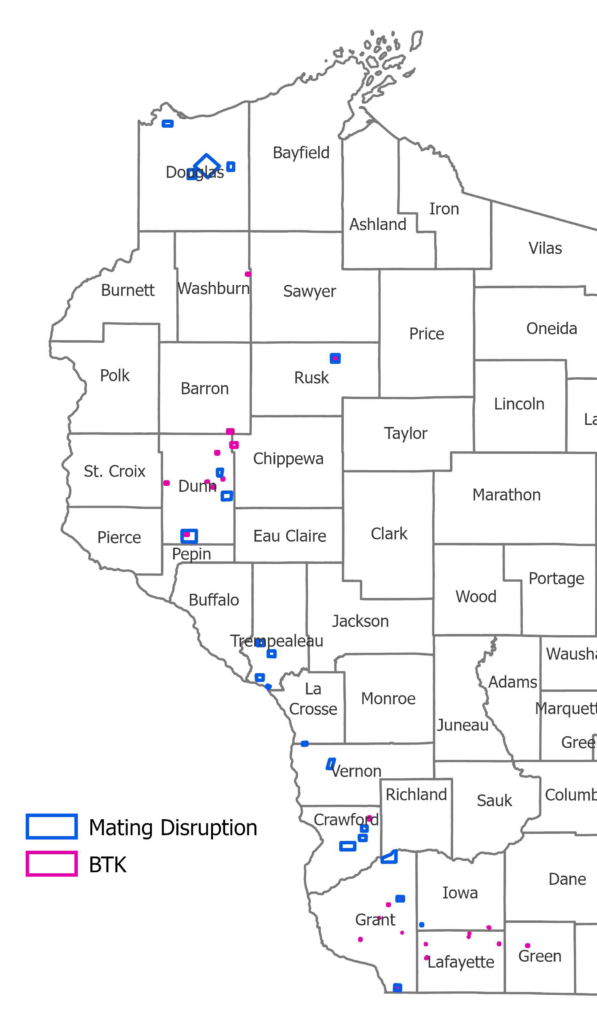By Bill McNee, DNR Forest Health Specialist, Oshkosh, bill.mcnee@wisconsin.gov or 920-360-0942

Gypsy moth egg masses on the underside of a maple branch.
Gypsy moth egg masses are expected to start hatching in April as temperatures warm. Now is a great time to do an egg mass inspection to look for unknown infestations and treat or remove any masses within reach. Each mass that never hatches can result in 500 to 1,000 fewer leaf-eating caterpillars.
Egg masses are tan-colored lumps about the size of a nickel or quarter. They can be found on many outdoor surfaces, including tree trunks, undersides of branches, buildings, rocks, fences, retaining walls, firewood piles and other outdoor objects.
If egg masses are found, there are two options to help reduce pest numbers. Directly spray horticulture oils on the egg masses to suffocate them. These oils are typically applied when temperatures are above 40 degrees and not expected to dip below freezing for a few days. Adding a little food coloring to the spray mix helps identify the treated masses and shows the public that oiling has been done. Egg masses within reach can also be scraped into a can of soapy water and left to soak for a few days before being thrown in the trash. Target “fresh” egg masses that were produced during the previous summer. Older masses that are faded and feel spongy do not contain viable eggs.
The summer of 2020 saw a significant rebound of the gypsy moth population after several years of weather conditions unfavorable for the non-native defoliator. Also, it is believed that the cold temperatures in February 2021 did not cause heavy egg mortality in most of the state. The highest populations are usually found where oaks and other preferred species are growing on mowed lawns, street terraces or sandy soil. Visit the webpage here for a survey method predicting the level of this summer’s defoliation.
Insecticide treatments (injections, soil drenches or sprays) may be appropriate for larger trees with many egg masses. Some treatment types are done before the eggs hatch, and some are done while the caterpillars are small. A directory of for-hire certified arborists is available on the Wisconsin Arborist Association website, and other businesses offering insecticide treatments may be found online or in a phone book. Check the qualifications of any business hired to perform insecticide treatments.
Additional information about physical controls, including sticky barrier bands and burlap collection bands, is available on the Wisconsin gypsy moth website. This website can also be a useful reference link on municipal websites. It also contains a guide that will help those interested in an aerial spray to protect larger areas of high-value, susceptible hosts.
Slow-The-Spread Aerial Treatments Announced

Map of proposed 2021 DATCP gypsy moth slow-the-spread treatments. Bacterial insecticide (Btk) treatments are shown in purple and mating disruption (pheromone) treatments are shown in blue.
The Wisconsin Department of Agriculture, Trade and Consumer Protection (DATCP) announced its planned 2021 Slow-The-Spread gypsy moth treatments in western counties. About 95,000 acres are scheduled for treatment at 45 sites in 14 counties, using low-flying airplanes.
Counties with sites scheduled to receive aerial treatments are: Barron, Chippewa, Crawford, Douglas, Dunn, Grant, Green, Iowa, La Crosse, Lafayette, Rusk, Trempealeau, Vernon and Washburn. The combined 8,133 acres will be treated two times with a bacterial insecticide containing Bacillus thuringiensis kurstaki (Btk). A mating disruption (pheromone) treatment will be applied once over 86,466 acres.
Treatments will likely begin in May and continue through late July or early August. The treatment areas are primarily rural forests, but there is some treatment acreage within a village or city’s boundaries. Other treatment sites are very close to a village or city, and the low-flying aircraft may be noticed.
Additional information, detailed maps and treatment updates can be found online at the DATCP Gypsy Moth website.
